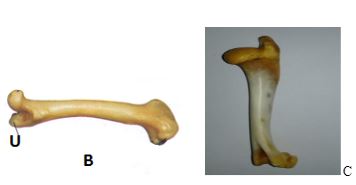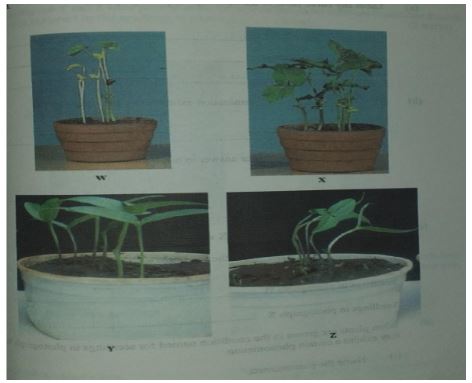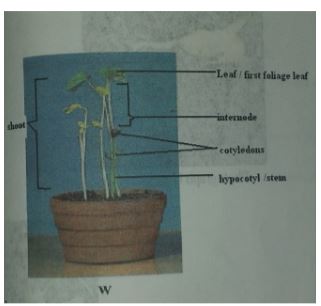Biology
Paper 3
(Practical)
Instructions to candidates
- Answer all the questions in the spaces provided.

Questions
- You are provided with irish potato tuber labeled specimen K, use it to answer questions that follow.
Cut out two cubes whose sides measure 1cm from the irish potato provided
Label three test-tubes as, A, B and C and put them into the test-tube rack.- Crush one cube to obtain a paste and add about 15 cm3 of distilled water to the paste to form a solution and then carry out the following procedure;
- Use a measuring cylinder to pour 10 cm3 of potato extract solution into test-tube A.
- Use the measuring cylinder to transfer 5 cm3 of potato solution extract from test-tube A to test- tube B.
- Use the measuring cylinder to add 5 cm3 of distilled water to test-tube B. Place a stopper in test-tube B and shake it.
- Remove the stopper. Use the measuring cylinder to transfer 5 cm3 of the liquid in test- tube B to test-tube C.
- Use the measuring cylinder to add 5 cm3 of distilled water to test-tube C. Place a stopper in test-tube C and shake it. Using a measuring cylinder reduce the volume of solution C to 5 cm3.
- Table below shows the percentage concentration of the potato extract solution.
Test tube Percentage concentration of potato extract solution A 100.00 B C
Complete the table above by calculating and writing in the percentage concentration of potato extract solutions in test-tube B and C. (2mks) - Using a measuring cylinder pour 1 cm3 to each of hydrogen peroxide to the contents in test tube A to C and make the observations (3mk)
Test tube Observations A B C - What was the aim of the investigation above (1mk)
- Write the word equation for the reactions taking place in the test tubes (1mk)
- What will be the expected observation if the irish potato was replaced with a piece of mammalian liver (1mk)
- Explain your answer in c (iii) above (2mk)
- Table below shows the percentage concentration of the potato extract solution.
- Crush the remaining cube to obtain the paste. Use the reagents provided to and carry out food test on the extract. (4mks)
TEST PROCEDURE OBSERVATIONS CONCLUSION
- Crush one cube to obtain a paste and add about 15 cm3 of distilled water to the paste to form a solution and then carry out the following procedure;
- You are provided with specimens labeled L and M. Study them then answer questions that follow:
- Identify the specimens. (2mk)
L
M - Name the part of the body where each is found. (2mk)
L
M - State three adaptive characteristic features of the bone L. (3mks)
- State two observable differences between bones L and M. (2mks)
Bone L Bone M - Study the diagrams below and answer questions that follow.
- Identify the bone labelled C in the diagram. (1mk)
- Name the type of joint and bone formed at the proximal and distal end of bone B (4mks)
- Proximal end;
- Bone …………………..………………….
- Type of joint ……………………………..
- Distal end;
- Bone(s)………………………………….
- Type of joint ……………………………
- Proximal end;
- Identify the specimens. (2mk)
- The photo graphs labelled W, X, Y and Z show seedlings that were grown under different conditions. Examine them.
- Label any two parts of the seedlings in photograph W. (2 mks)
-
- Name the type of germination exhibited by the seedlings. (1 mk)
- Give a reason for your answer in b(i) above. (1 mk)
- Seedlings in photographs W and X were planted at the same time. State the conditions under which the seedlings were grown. (2 mks)
- Seedlings in photograph W.
- Seedlings in photograph X.
- When plants are grown in the condition named for seedlings in photograph W, they exhibit a certain phenomenon.
- Name the phenomenon. (1 mk)
- State the significance of the phenomenon named in d(i). (1 mk)
- Using observable features only, state two differences between the seedlings in photographs W and X. (2 mks)
W X - Seedlings in photographs Y and Z were planted at the same time but under different conditions. Explain how the response exhibited by seedlings in photograph Z occurred. (2 mks)

Confidential
Each candidate should be provided with the following requirements;
- Specimen L - Axis vertebra
- Specimen M - Lumbar vertebra
- Irish potato tuber
- Scalpel
- 10 ml measuring cylinder
- 5 test tubes in a test tube rack
- 20% Hydrogen peroxide
- Benedict’s solution
- Iodine solution
- Morta and apestle
- Source of heat
- A ruler
- Distilled Water in a wash bottle.

Marking Scheme
- You are provided with irish potato tuber labeled specimen K, use it to answer questions that follow.
Cut out two cubes whose sides measure 1cm from the irish potato provided
Label three test-tubes as, A, B and C and put them into the test-tube rack.- Crush one cube to obtain a paste and add about 15 cm 3 of distilled water to the paste to form a solution and then carry out the following procedure;
- Use a measuring cylinder to pour 10 cm 3 of potato extract solution into test-tube A.
- Use the measuring cylinder to transfer 5 cm 3 of potato solution extract from test-tube A to test- tube B.
- Use the measuring cylinder to add 5 cm 3 of distilled water to test-tube B. Place a stopper in test-tube B and shake it.
- Remove the stopper. Use the measuring cylinder to transfer 5 cm 3 of the liquid in test- tube B to test-tube C.
- Use the measuring cylinder to add 5 cm 3 of distilled water to test-tube C. Place a stopper in
test-tube C and shake it. Using a measuring cylinder reduce the volume of solution C to 5 cm 3 .- Table below shows the percentage concentration of the potato extract solution.
Test tube Percentage concentration of potato extract solution A 100.00 B 50.00 C 25.00
Complete the Table above by calculating and writing in the percentage concentration of potato extract solutions in test-tube B and C. 2mks - Using a measuring cylinder pour 1 cm 3 to each of hydrogen peroxide to the contents in test tube A to C and make the observations 3mks
Test tube Observations A A lot/ more/ high amount of effervescence/bubbles B Moderate/ average amount of bubbles/effervescence C Little / few/small amount of effervescence/bubbles - What was the aim of the investigation above 1mk
- To determine the effect of catalase (enzyme) concentrarion on the rate of reaction/oxygen production
- To determine the effect of catalase (enzyme) concentrarion on the rate of reaction/oxygen production
- write the word equation for the reactions taking place in the test tubes 1mk
catalase
Hydrogen peroxide → Water + Oxygen
enzyme - What will be the expected observation if the irish potato was replaced with a piece of mammalian liver 1mk
- More effervescence/ bubbles produced when of liver was used as compared to when of irish potato was used.
- More effervescence/ bubbles produced when of liver was used as compared to when of irish potato was used.
- Explain your answer in c (iii) above 2mk
- Liver is animal excretory organ; liver has a high concentration of catalase enzymes to break down high level of toxic hydrogen peroxide produced in the liver.
- Liver is animal excretory organ; liver has a high concentration of catalase enzymes to break down high level of toxic hydrogen peroxide produced in the liver.
- What was the aim of the investigation above 1mk
- Table below shows the percentage concentration of the potato extract solution.
- Crush the remaining cube to obtain the paste. Use the reagents provided to and carry out food test on the extract. (4mks)
TEST PROCEDURE OBSERVATIONS CONCLUSION Iodine test To 2 ml of food substance/
potato extract (solution)
add 2/3 drops of iodine
solution and shakeThe colour changes to
blue – blackStarch present Benedict’s
testTo 2 ml of food substance/
potato extract (solution)
add equal amount of
Benedict’s solution and
heat to boilThe blue colour of
Benedict’s solution is
retained/ remainReducing sugars
absent
- Crush one cube to obtain a paste and add about 15 cm 3 of distilled water to the paste to form a solution and then carry out the following procedure;
- You are provided with specimens labeled L and M. Study them then answer questions that follow:
- Identify the specimens. (2mk)
- L..Axis vertebra
- M..Lumbar vertebra
- Name the part of the body where each is found. (2mk)
- L..Neck region
- M..Abdominal region
- State three adaptive characteristic features of the bone L. (3mks)
- Has an odontoid process that fits into the neural canal of the atlas and allows for rotational movements of the head.
- Has a broad neural spine for attachment of neck muscles.
- Has a neural canal for passage of spinal cord
- Has a neural arch that protects the spinal cord
- State two observable differences between bones L and M. (2mks)
Bone L Bone M Has short transverse processes Large,well-developed transverse processes Has an odontoid process Lacks odontoid process - Study the diagrams below and answer questions that follow.
- Identify the bone labelled C in the diagram. (1mk)
- Humerus
- Name the type of joint and bone formed at the proximal and distal end of bone B (4mks)
- Proximal end.
- Bone…Pelvic/hip girdle
- Type of joint…ball and socket join
- Distal end:
- Bone(s)…Tibia and fibula
- Type of joint…Hinge joint
- Proximal end.
- Identify the bone labelled C in the diagram. (1mk)
- Identify the specimens. (2mk)
- The photo graphs labelled W, X, Y and Z show seedlings that were grown under different conditions. Examine them.
- Label any two parts of the seedlings in photograph W. (2 marks)
-
- Name the type of germination exhibited by the seedlings. (1 mk)
- Epigeal
- Epigeal
- Give a reason for your answer in b(i) above. (1 mk)
- Cotyledons move above the ground/above soil
- Cotyledons move above the ground/above soil
- Name the type of germination exhibited by the seedlings. (1 mk)
- Seedlings in photographs W and X were planted at the same time. State the conditions under which the seedlings were grown. (2 Mks)
- Seedlings in photograph W.
- Grown in the dark/insufficient light/absence of light
- Grown in the dark/insufficient light/absence of light
- Seedlings in photograph X.
- Grown in light/sufficient light/adequate light
- Grown in light/sufficient light/adequate light
- Seedlings in photograph W.
- When plants are grown in the condition named for seedlings in photograph W, they exhibit a certain phenomenon.
- Name the phenomenon. (1 mk)
- Etiolation
- Etiolation
- State the significance of the phenomenon named in d(i). (1 mk)
- To reach /search/obtain/seek light
- To reach /search/obtain/seek light
- Name the phenomenon. (1 mk)
- Using observable features only, state two differences between the seedlings in photographs W and X. (2mks)
W X Long internodes/stems Short internodes/stem Long and thinner stem Short and thicker stem Yellow/light green leaves Green leaves Small leaves Large/big leaves - Seedlings in photographs Y and Z were planted at the same time but under different conditions. Explain how the response exhibited by seedlings in photograph Z occurred. (2 mks)
- Seedling subjectedto unidirectional/source of light; causes Auxins to migrate/diffuse/move to the dark side of the shoot; high auxins conc. On the dark side;causing faster cell elongation on that side than on the lit side hence the bending
N/B sequence must be right
- Seedling subjectedto unidirectional/source of light; causes Auxins to migrate/diffuse/move to the dark side of the shoot; high auxins conc. On the dark side;causing faster cell elongation on that side than on the lit side hence the bending
- Label any two parts of the seedlings in photograph W. (2 marks)
Download Biology Paper 3 Questions and Answers with Confidentials - Mokasa II Mock Examination 2021/2022.
Tap Here to Download for 50/-
Get on WhatsApp for 50/-
Why download?
- ✔ To read offline at any time.
- ✔ To Print at your convenience
- ✔ Share Easily with Friends / Students




